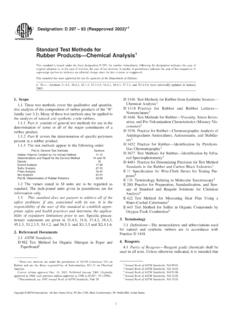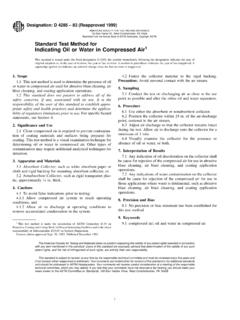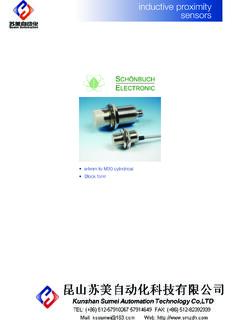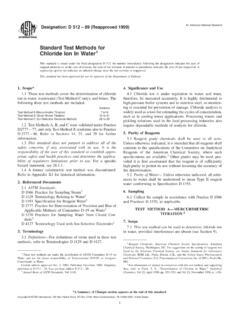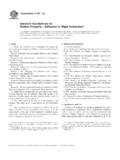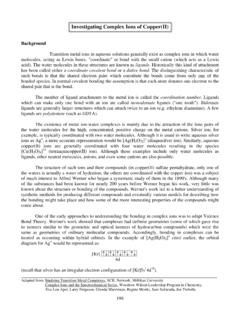Transcription of Standard Test Method for Hardness in Water - file.yizimg.com
1 An American National Standard Designation: D 1126 02. Standard Test Method for Hardness in Water1. This Standard is issued under the fixed designation D 1126; the number immediately following the designation indicates the year of original adoption or, in the case of revision, the year of last revision. A number in parentheses indicates the year of last reapproval. A. superscript epsilon (e) indicates an editorial change since the last revision or reapproval. This Standard has been approved for use by agencies of the Department of Defense. 1. Scope For definitions of other terms used in this test Method , This test Method covers the determination of Hardness in refer to Terminology D 1129.
2 Water by titration. This test Method is applicable to waters that 4. Summary of Test Method are clear in appearance and free of chemicals that will complex calcium or magnesium. The lower detection limit of this test Calcium and magnesium ions in Water are sequestered Method is approximately 2 to 5 mg/L as CaCO3; the upper limit by the addition of disodium ethylenediamine tetraacetate. The can be extended to all concentrations by sample dilution. It is end point of the reaction is detected by means of Chrome Black possible to differentiate between Hardness due to calcium ions T4, which has a red color in the presence of calcium and and that due to magnesium ions by this test Method .
3 Magnesium and a blue color when they are sequestered. This test Method was tested on reagent Water only. It is 5. Significance and Use the user's responsibility to ensure the validity of the test Method for waters of untested matrices. Hardness salts in Water , notably calcium and magne- This Standard does not purport to address all of the sium, are the primary cause of tube and pipe scaling, which safety concerns, if any, associated with its use. It is the frequently causes failures and loss of process efficiency due to responsibility of the user of this Standard to establish appro- clogging or loss of heat transfer, or both.
4 Priate safety and health practices and determine the applica- Hardness is caused by any polyvalent cations, but those bility of regulatory limitations prior to use. other than Ca and Mg are seldom present in more than trace amounts. The term Hardness was originally applied to Water in 2. Referenced Documents which it was hard to wash; it referred to the soap-wasting ASTM Standards: properties of Water . With most normal alkaline Water , these D 1066 Practice for Sampling Steam2 soap-wasting properties are directly related to the calcium and D 1129 Terminology Relating to Water2 magnesium content.
5 D 1193 Specification for Reagent Water2 6. Interferences D 3370 Practices for Sampling Water from Closed Con- duits2 The substances shown in Table 1 represent the highest D 5847 Practice for Writing Quality Control Specifications concentrations that have been found not to interfere with this for Standard Test Methods for Water Analysis3 determination. The test Method is not suitable for highly colored 3. Terminology waters, which obscure the color change of the indicator. Definitions: equivalent per million (epm), n a unit chemical equivalent weight of solute per million unit weights of solu- tion.
6 Laboratory control sample, n a solution with certified Hardness . 4. 3 Hydroxy 4-(1 hydroxy-2 napththyl) azo-7 nitro 1 naphthalenesulfonic 1. acid, sodium salt, Color Index 14645. This test Method is under the jurisdiction of ASTM Committee D19 on Water and is the direct responsibility of Subcommittee on Inorganic Constituents in Water . Current edition approved May 10, 2002. Published June 2002. Originally published as D1126 50 T. Last previous edition D1126 96. 2. Annual Book of ASTM Standards, Vol 3. Annual Book of ASTM Standards, Vol Copyright ASTM International, 100 Barr Harbor Drive, PO Box C700, West Conshohocken, PA 19428-2959, United States.
7 1. D 1126 02. TABLE 1 Freedom of Reaction from Interferences Ammonium Hydroxide Solution (1 + 4) Mix 1 volume Maximum Maximum of NH4OH (sp gr ) with 4 volumes of Water . Concentration Concentration Buffer Solution Prepare the buffer solution in three Without Without Substance Interference Interference steps as follows: in the Total in the Calcium Dissolve 40 g of sodium tetraborate Hardness Hardness (Na2B4O7 10H2O) in 800 mL of Water . Test, mg/L Test, mg/L. Dissolve 10 g of sodium hydroxide (NaOH), 10 g of Aluminum, Al+++ 20 5. sodium sulfide (Na2S 9H2O), and 10 g of potassium sodium Ammonium, NH4+ A.
8 2 000 tartrate (KNaC4O6 4H2O) in 100 mL of Water . Bicarbonate, HCO3 .. 500 When cool mix the two solutions and add 1 g of Bromine, Br .. 2. Cadmium, Cd++ 20 .. magnesium disodium ethylenediamine tetraacetate, having a Carbonate, CO3 1 000 50 magnesium-to-EDTA mole ratio of 1 to 1. Make up to 1 L with Chloride, Cl 10 000 .. Water . Keep the solution bottle stoppered when not in use. The Chlorine, Cl .. 2. Chromate, CrO4 500 500 reagent will be effective for at least 1 month. Cobalt, Co++ .. Calcium Solution, Standard (1 mL = mg CaCO3) . Copper, Cu++ 20 2 Dissolve g of CaCO3 in 3 to 5 mL of HCl (1 + 4).
9 Dilute Iron, ferric, Fe+++ 10B 20. Iron, ferrous, Fe++ 10B 20 to 1 L with Water . Lead, Pb++ 20 5 Calcium Indicator Use powdered hydroxynaphthol Manganese, Mn++ 1C 10C blue,6 or grind solid hydroxynaphthol blue to 40 to 50 mesh Nickel, Ni++ .. Nitrate, NO3 500 500 size. Nitrite, NO2 500 500 Hardness Indicator The Hardness indicator can be Phosphate, PO4 100 .. prepared, stored, and used in liquid or powder form. Silicate, SiO3 200 100. Strontium, Sr++ E E Hardness Indicator Solution Dissolve g of Sulfate, SO4 10 000 10 000 Chrome Black T3 in 50 mL of diethanolamine or triethanola- Sulfite, SO3 500 500 mine.
10 Store the solution in a dark-colored bottle. This solution Tannin, Quebracho 200 50. Tin, stannic, Sn++++ 10 5 has a storage life of several months. Tin, stannous, Sn++ 10 5 Hardness Indicator Powder Grind g of Chrome Zinc, Zn++ 20 5 Black T3 with 100 g of powdered sodium chloride. Use a A. No data are available. dark-colored bottle for storage. The powder has a storage life B. Iron will not interfere in concentrations up to 200 mg/L. However, the red color of the end point may return in about 30 s. of at least 1 year. C. Manganese will not interfere in concentrations up to 10 mg/L if a few crystals Hydrochloric Acid (1 + 4) Mix 1 volume of concen- of K4Fe(CN)6 3H2O are added to the buffer immediately before use.


